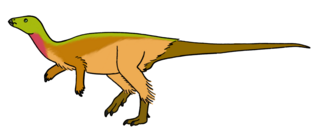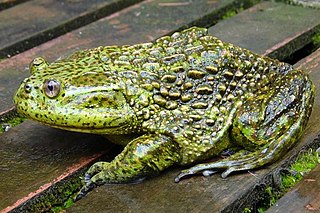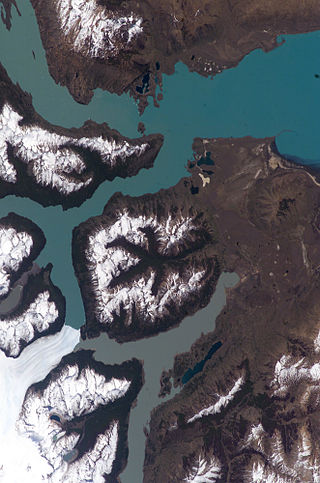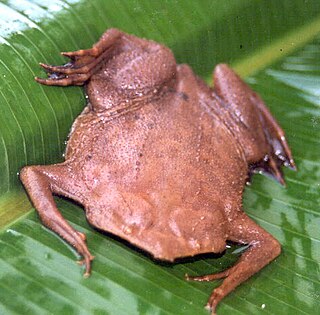
The Neobatrachia are a suborder of the Anura, the order of frogs and toads.

The Pipidae are a family of primitive, tongueless frogs. There are 41 species in the family, found in tropical South America and sub-Saharan Africa.

Notohypsilophodon is a genus of ornithopod dinosaur from the Late Cretaceous of Argentina. It was described as the only "hypsilophodont" known from South America, although this assessment is not universally supported, and Gasparinisaura is now believed to have been a basal euornithopod as well.

Telmatobufo is a genus of frogs endemic to southern Chile. Their closest living relative is the monotypic helmeted water toad, Calyptocephalella gayi. These frogs were recently removed from the Leptodactylidae and placed in a new family, the Calyptocephalellidae. All three species of Telmatobufo that have been assessed by the IUCN are considered threatened.

A true toad is any member of the family Bufonidae, in the order Anura. This is the only family of anurans in which all members are known as toads, although some may be called frogs. The bufonids now comprise more than 35 genera, Bufo being the best known.
Polarornis is a genus of prehistoric bird, possibly an anserimorph. It contains a single species Polarornis gregorii, known from incomplete remains of one individual found on Seymour Island, Antarctica, in rocks which are dated to the Late Cretaceous.

Seymour Island or Marambio Island, is an island in the chain of 16 major islands around the tip of the Graham Land on the Antarctic Peninsula. Graham Land is the closest part of Antarctica to South America. It lies within the section of the island chain that resides off the west side of the peninsula's northernmost tip. Within that section, it is separated from Snow Hill Island by Picnic Passage, and sits just east of the larger key, James Ross Island, and its smaller, neighboring island, Vega Island.

Telmatobufo bullocki is a species of frog in the family Calyptocephalellidae. It is endemic to Chile, and is only known from a few locations in the Cordillera de Nahuelbuta, a part of the Chilean Coast Range. It is extremely rare; extensive fieldwork in 1992–2002 turned up only a single adult. It occurs in fast-flowing streams in temperate Nothofagus forest. The tadpoles are free-swimming and feed on algae growing on submerged rocks. It is threatened by siltation of streams caused by clear-cutting. It occurs within the Nahuelbuta National Park.

Hyloidea is a superfamily of frogs. Hyloidea accounts for 54% of all living anuran species. The superfamily Hyloidea branched off from its closest relative, the Australobatrachia, during the mid-Cretaceous. The fossil evidence found during the Cretaceous-Paleogene extinction event could not determine the effects upon the frogs, due to the lack of fossils. Increased forestation erupted after this extinction, possibly leading to more arboreal adaptations of these anurans to be best suited for this habitat.

The Allen Formation is a geological formation in Argentina whose strata date back to the Late Cretaceous (middle Campanian to early Maastrichtian. Dinosaur remains are among the fossils that have been recovered from the formation. Indeterminate chelid remains and other vertebrates have also been discovered in this formation.
Vulcanobatrachus is an extinct genus of fossil frog. The genus contains the single species Vulcanobatrachus mandelai found at Marydale, South Africa, described in 2005 and named after Nelson Mandela. The genus owes its name to the fact that fossils were recovered from an extinct volcanic crater lake of Late Cretaceous age. The fossil frogs are assumed to have died following a limnic eruption (a degassing event possibly of CO2) by the volcano.

Calyptocephalella is a genus of frogs in the family Calyptocephalellidae. It is represented by a single living species, Calyptocephalella gayi, commonly known as the helmeted water toad, Chilean helmeted bull frog, or wide-mouthed toad. Additionally, there are a few extinct species that are only known from Late Cretaceous and Paleogene fossil remains from Patagonia in South America and the Antarctic Peninsula. The helmeted water toad living today is aquatic to semi-aquatic, and found in deep ponds and reservoirs in central Chile and possibly adjacent west-central Argentina.

The Chorrillo Formation, also named as Chorillo Formation, is a Maastrichtian geologic formation in southern Patagonia, Argentina. The formation is more than 50 metres (160 ft) thick and underlies the Calafate Formation and rests on top of the La Irene Formation.

Pipoidea are a clade of frogs, that contains the most recent common ancestor of living Pipidae and Rhinophrynidae as well as all its descendants. It is broadly equivalent to Xenoanura.
Sudamericidae is a family of gondwanathere mammals that lived during the late Cretaceous to Miocene. Its members include Lavanify and Vintana from the Cretaceous of Madagascar, Bharattherium (=Dakshina) from the Cretaceous of India, Gondwanatherium from the Cretaceous of Argentina, Sudamerica from the Paleocene of Argentina, and unnamed forms from the Eocene of Antarctica and Cretaceous of Tanzania. More recently, Patagonia, a mammal from the Colhuehuapian stage of the Miocene of southern South America, has been suggested to be a sudamericid.

Pelodryadinae, also known as Australian treefrogs, is a subfamily of frogs found in the region of Australia and New Guinea, and have also been introduced to New Caledonia, Guam, New Zealand, and Vanuatu.

Phyllomedusinae is a subfamily of hylid tree frogs found in the Neotropics commonly called leaf frogs. Formerly, they were often considered as their own family, Phyllomedusidae.

Myobatrachoidea is a superfamily of frogs. It contains two families, both of which are found in Australia, New Guinea, and the Aru Islands. Some sources group these two families into a single family Myobatrachidae.

Australobatrachia is a clade of frogs in the suborder Neobatrachia. It comprises three families of frogs with a Gondwanan distribution, being known from Chile, Australia, and New Guinea. Together, they form the sister group to the superfamily Hyloidea.

Yatenavis is an extinct genus of enantiornithine bird from the Late Cretaceous Chorrillo Formation of Santa Cruz Province, Argentina. The genus contains a single species, Y. ieujensis, known from a partial humerus.


















